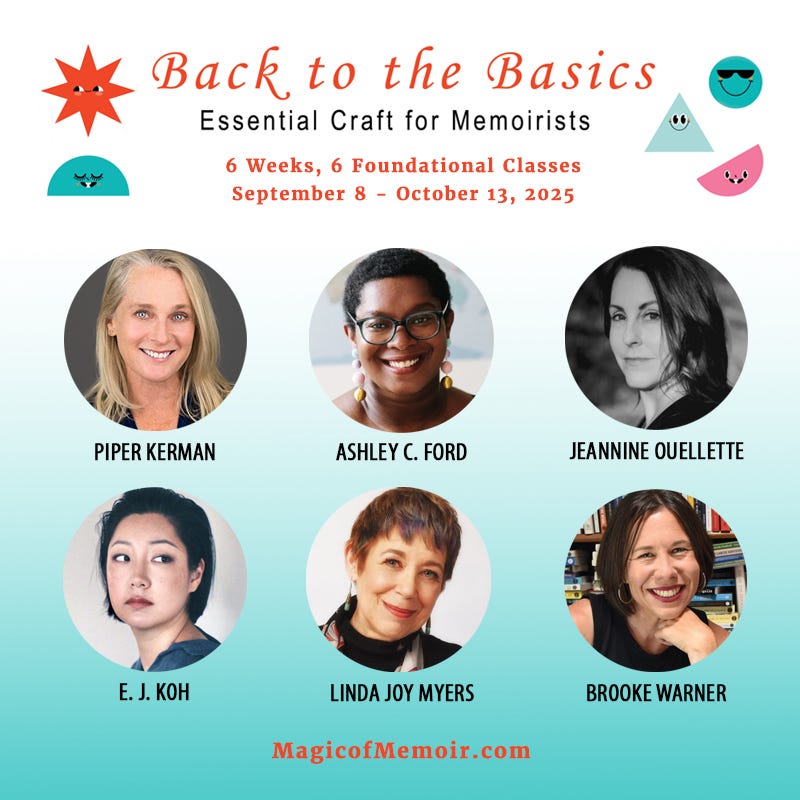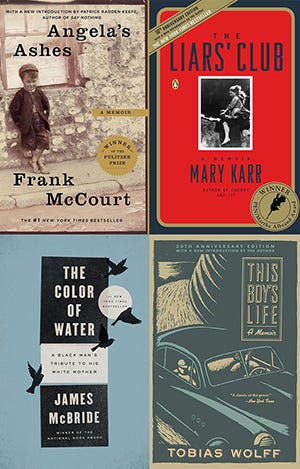Back to the Basics
Why we're teaching the foundations of memoir this fall (with Piper Kerman, Ashley C. Ford, E.J. Koh, and Jeannine Ouellette)
I’ve taught memoir intensively (by which I mean once a week or more often) for the past 15 years. Lately, I’ve been thinking a lot about where I was in the before—because this 15-year milestone represents a turning point moment, when I took a leap of faith to start She Writes Press and to start teaching memoir.
The landscape of book publishing and online classes has changed so dramatically that I scarcely think my 2010 self would be able to comprehend its complexity if you were to pluck her from her desk at Seal Press and drop her into today’s publishing environment. And yet, the final memoirs I acquired before I left are exactly the kinds of books I’m still publishing today: We Hope You Like This Song (a coming-or-age memoir about friendship and loss); Stranger Here (a memoir about how weight loss surgery didn’t give the author the magic pill solution she was looking for); Pale Girl Speaks (an advocacy memoir about skin cancer); Hot & Heavy (an anthology of personal fat-positive essays on body image and fashion).
The culture changes, and trends come and go, but memoirs that endure stay with us in our hearts and our minds. Also, they stay in print. There’s a reason all these books I acquired 15 years are still for sale: They’re still finding readers.
The first memoir I ever read was Prozac Nation, close to the time I decided I wanted to get into book publishing (2000). It was about being young and depressed in America. I was young, but I wasn’t depressed. Still, the book changed my life. It was the rawness of it. It was that someone dared to talk about things in the pages of that book that I’d never talked about with anyone before. It was as intimate as a journal, but written like a novel, in scene. It was my first true awareness of memoir as a genre. I wouldn’t start to specialize in memoir in earnest until I landed at Seal Press in 2004, but looking back, I think the genre chose me.
Prozac Nation was criticized, of course, for being “self-indulgent,” but also praised for being “self-aware.” All good memoirs are. The New York Times review offered that its “self-pitying passages make the reader want to shake the author, and remind her that there are far worse fates than growing up during the ’70s in New York and going to Harvard.” Yes, that’s right—how dare you be depressed when you’ve been given every privilege America has to offer!
Since Prozac Nation, I’m sure I’ve read a thousand-plus memoirs. I wish I’d kept count all these years. I’ve read every topic and every category and every classification and every structure. In the past two years, memoir has gone through exciting and explosive growth. If you’ve been tracking, we’ve been in a Golden Age for the genre. It’s ushered in many seminal voices and books, and it’s also created a lot of blurred lines about what constitutes a memoir. Suddenly, it seems, memoir can be anything that includes personal narrative. There’s memoir-plus; prescriptive/self-help memoir; memoir manifestos; memoirs in essay; hybrid memoirs; genre-blending memoirs; experimental memoir; mostly true memoirs; and I’m sure I’m forgetting what-else-kind-of-memoir.
Bring it! Self-expression is what matters, after all.
And/however . . .
The blurring of the lines comes with certain inherent risks. When boxes get blown up by others, and especially when said others are praised and become best-selling authors, some writers think: Hurray, complete freedom to do whatever I want! Not so. There are few successful authors who haven’t honed their craft with years and years of writing classes. Few who don’t know the basics of their genre (even if they choose to bend the rules). Few who themselves haven’t read and studied countless memoirs.
This recent surge of experimentation in memoir has forever changed the genre. There is no going back. Most of the students coming to my classes are drawn to “memoir as fragmented”: hybrid, collage, mosaic, nonlinear. I have no doubt we’ll look back at this era as marking the rise of this particular form. But, it’s not the only way to write a memoir, and the hallmarks of good memoir—scene, characterization, narration, reflection—are inescapable. I’ve read entire manuscripts lacking the basics, and they read like journals, or summaries of a life not yet compelling enough for any kind of readership beyond an immediate circle of friends and family.
All of this is the reason I’m co-hosting Back to the Basics this fall with Linda Joy Myers (National Association of Memoir Writers). We teach these courses in the spring and the fall. We’ve offered Women Writing Memoir, The Heart of Memoir, Craft Essentials, The Evolution of Memoir, and countless others. Back to the Basics begged itself to be taught in part because of what we’re reading: too much content that’s lacking the fundamentals. I don’t care how beautiful your prose is; you’ve got to know the genre in which you’re writing. You must allow yourself the gift of studying the craft—and never believe that you’ve arrived. The beauty of being a writer is that you get to keep learning forever. I learn something new every time I read a new memoir.
If any or all of this resonates with you, check out our fall offering, Back to the Basics. As always, the roster of guest teachers is swoon-worthy. Look at these women.
6 Mondays:
September 8, 15, 22, 29, October 6, 13
Class 1: Scene Foundations, with Jeannine Ouellette
(listen to Ouellette, author of The Parts That Burn, on Memoir Nation, formerly Write-minded)
Class 2: Action and Conflict, with Piper Kerman
(listen to Kerman, author of Orange Is the New Black, on Memoir Nation, formerly Write-minded)
Class 3: Character and Characterization, with Ashley C. Ford
(listen to Ford, author of Somebody’s Daughter, on Memoir Nation, formerly Write-minded)
Class 4: Memory and the Narrative Lens, with Linda Joy Myers
Class 5: Reflection and Takeaway, with Brooke Warner
Class 6: Choosing Which Scenes to Write, with E.J. Koh
(listen to Koh, author of The Magical Language of Others, on Memoir Nation, formerly Write-minded)
In case you’re wondering, all of these sessions focus on scene in some capacity. No matter how fragmented or experimental your work—if you’re a poet or a collagist or a essayist—until you’ve mastered scene, you might be in the game, but not you’re not in the game. Scene is everything.
Also, icing on the cake for those of you who are feeling ready to exercise your brain with the heavier set of weights, we’re offering a supplementary reading group called Where It All Began: The Roots of Modern Memoir. Here, we’ve chosen some classics, memoirs that we believe ushered in the previous revolutionary era, those books that made way for memoir to become the celebrated genre that it is today.
Come discuss and dissect these books with us. Whether you love them, are bewildered by them, have strong feelings about them, want to throw them or emulate them, we are up for it all. Yes, it will involve a lot of reading! So, stop doom-scrolling, grab these books, and join us in November. You’ll have some very interesting non-political things to talk about at Thanksgiving dinner!
4 Mondays:
November 3, 10, 17, 24
$99
Class 1. Angela’s Ashes, by Frank McCourt
Class 2. The Liars’ Club, by Mary Karr
Class 3. The Color of Water, by James McBride
Class 4. This Boy’s Life, by Tobias Wolff






I love Jeannine and follow her on Substack. She will be a wonderful addition to your team of stars.
Wonderful! All of this. So glad you are such a champion of memoir.